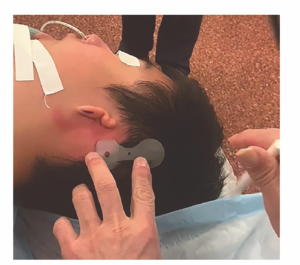INTRODUCTION
Bone conduction devices provide access to sound in children who are otherwise unable to wear or gain benefit from conventional hearing aids. They are used to treat conductive and sensorineural hearing losses resulting from a variety of etiologies, such as aural atresia or single-sided deafness. The application of such devices has been limited in part by soft tissue complications, particularly those associated with skin-penetrating abutments.
Explore This Issue
October 2022METHOD
The study protocol was approved by the Research Ethics Board at the Hospital for Sick Children. All devices were purchased by our institution.
Children who were 18 years of age or younger and who lacked sufficient benefit from percutaneous osseointegrated or nonsurgical bone conduction devices were eligible for participation in this study. The first five devices were inserted following case-by-case approval through Health Canada’s special access program. The remaining 38 devices were implanted after the OSIA2 was approved for clinical use. The described use of the OSIA2 in children under 12 is considered off-label from the perspective of the Food and Drug Administration. (For the key elements of an OSIA2 insertion in an older child with left-sided microtia and aural atresia, see the supplemental video.)
Device placement and preoperative marking. Placement of the device was carefully determined using a modified silastic model. The silastic model was modified with a 2-mm biopsy punch through the neck of the model to allow for correct positioning of the external component. Considerations for implant placement include positioning the actuator no more than 2 cm posterior to the external auditory canal (EAC) and in line with a line drawn through the outer canthus of the eye to superior attachment of the pinna, which roughly denotes the vertical position of the cochlea. In patients who lack an EAC, device location is estimated based on surface landmarks, such as topography and curvature of the temporal bone as well as location of the mastoid tip, which is underdeveloped in aural atresia.
The thickness of the skin overlying the coil and the receiver–stimulator was measured using a 27-gauge needle. Surgical instructions from the manufacturer suggest reducing skin flap thickness if initially greater than 9 mm for optimal coupling of the internal and external devices. Further details on skin flap reduction techniques are described below.

Figure 1. Placement of the device posterior to the predicted location of the pinna and external auditory canal.
Methylene blue was used to identify the location for the implant, as well as the neck of the receiver–stimulator, through the holes in the template (Figure 1). An incision was drawn allowing for at least 1 cm of soft tissue clearance from the perimeter of the actuator. This incision was posteriorly based in the scalp for those with microtia and aural atresia and anteriorly based in the postauricular region for children with a typical pinna.